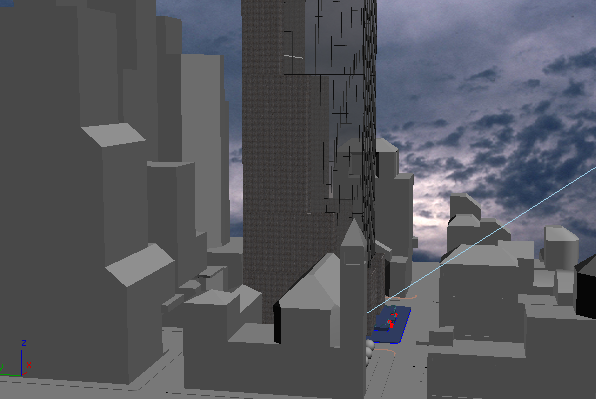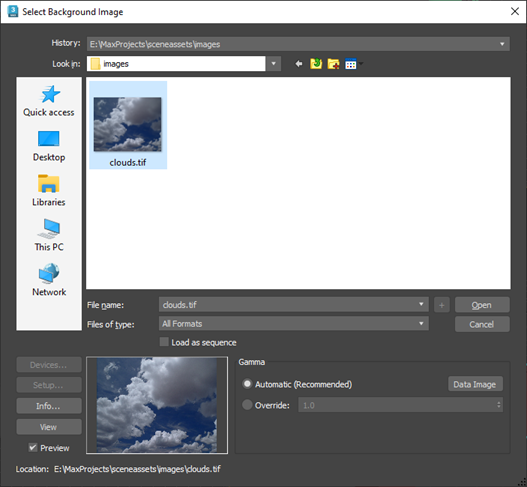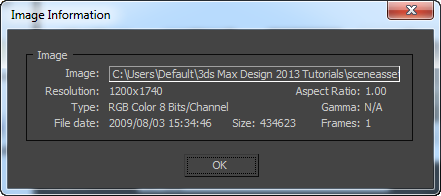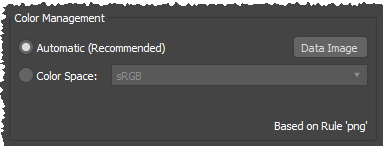The Select Background Image dialog allows you to choose a file or sequence of files for a viewport background.

Cityscape model with a sky image used as the viewport background
You can also convert a set of sequentially numbered files to an Image File List (IFL). This is the same process used by the IFL Manager Utility.
Procedures
To select a background image for a viewport:
- Activate the viewport where you want the image.
- Choose Views menu
 Viewport Background
Viewport Background  Viewport Background.
Viewport Background.
- Under Background Source in the dialog that displays, click Files.
- In the Look In field, navigate to the directory containing the file you want to use for the background.
Note: The Select Background Image File dialog uses the last location where a bitmap was chosen, rather than the default bitmap path defined on the Configure User Paths dialog.
- Highlight the file name in the file list window.
- Click Open to select the image and close the dialog.
- Click OK to close the Viewport Background dialog and display the background image.
To select a set of still images as a viewport background:
- Activate the viewport where you want the image.
- Choose Views menu
 Viewport Background
Viewport Background  Viewport Background.
Viewport Background.
- Under Background Source, click Files.
- In the Look In field, navigate to the directory containing the sequence of files.
The files must be sequentially numbered (for example, image01.bmp, image02.bmp, image03.bmp).
Tip: If necessary, change Files Of Type to match the file extension of the sequence, or choose All Formats. - Turn on Sequence, and choose the name of the first sequential file (for example,
image01.bmp).
Tip: Click the Setup button to display the Image File List Control dialog.
- In the Image File List Control dialog, use the Browse button to set the Target Path to a directory on your hard disk. Do not set this path to a CD-ROM drive, because you cannot save the file there.
- Choose the options you want, and then click OK.
The Image File List (IFL) file is saved to the target directory.
Interface

- History
- Displays a list of the most recent directories searched. Whenever an image is selected, the path used is added to the top of the history list as the most recently used path. The history information is saved in the 3dsmax.ini file.
- Look in
- Opens a navigation window to browse other directories or drives.
-
 Go To Last Folder Visited
Go To Last Folder Visited - Click to return to the folder you previously browsed to.
-
 Up One Level
Up One Level - Moves you up a level in the directory structure.
-
 Create New Folder
Create New Folder - Lets you create a new folder while in this dialog.
-
 View Menu
View Menu - Lets you choose the level of detail to display in the file list.
- Thumbnails: Displays the contents of a directory as thumbnails, without the details.
- Tiles: Displays the contents of a directory as large icons, without the details. If you widen the dialog, these tile across the width.
- Small Icons: Displays the contents of a directory as small icons, tiled across the width, without the details.
- List: Displays the contents of a directory without the details.
- Details: Displays the contents of a directory with full details such as size and date.
- [file list window]
- Lists the contents of the directory, in the format specified by the View menu.
Tip: When View Menu
 Details is chosen, the contents of the directory are displayed with Name, Size, Type, Date Modified, and Attributes. You can sort based on each of these columns by clicking the column label.
Details is chosen, the contents of the directory are displayed with Name, Size, Type, Date Modified, and Attributes. You can sort based on each of these columns by clicking the column label.
- File name
- Displays the file name of the file selected in the list.
- Files of type
- Displays all the file types that can be displayed. This serves as a filter for the list.
- Load as sequence
- If there are more than one files that have the same root name and end in sequence numbers, turning
Load as sequence creates an Image File List (IFL). Default=off.
Each time you choose an image, 3ds Max checks to see if an IFL sequence can be created. If the selected image does not yield a list, this option is unavailable.
You can use wild-card characters to filter image files. When Load as sequence is turned on, you can click Setup to configure the IFL file.
- Open
- Selects the highlighted file and closes the dialog.
- Cancel
- Cancels the selection and closes the dialog.
- Devices
- Lets you choose the hardware output device; for example, a digital video recorder. The device, its driver, and its 3ds Max plug-in must all be installed on your system to use the device.
- Setup
- When Sequence is turned on, and there are sequential files in the directory displayed, clicking Setup displays an Image File List Control dialog to create an IFL file.
- Info
- Displays expanded information about the file, such as frame rate, compression quality, file size, and resolution. The information here depends on the type of information that is saved with the file type.
If the file has an embedded value, this dialog displays that value. Otherwise, it displays "N/A".

- View
- Displays the file at its actual resolution. If the file is a movie, the Windows Media Player is opened so the file can be played.
- Preview
- Displays the image as a thumbnail in the image window. Default=on.
- Image Window
-
Displays a thumbnail of the selected file.
Gamma [Gamma Workflow color management mode only]
Specifies how to handle gamma for the bitmap image.
- Automatic (Recommended)
- Uses the gamma value embedded in the incoming bitmap. If there is no embedded gamma value,
3ds Max makes an intelligent decision based on the image's bit depth. Low-dynamic-range images (8- or 16-bit) are assumed to have the standard sRGB gamma of 2.2, and high-dynamic-range (floating-point or logarithmic) images are assumed to be linear and use a gamma of 1.0 (no correction).
For most scenes, you should leave the gamma-handling set to Automatic.
- Override
- Sets a user-defined gamma value as an override.
Note: Use Override only if your scene uses bitmaps created (or edited) by a variety of other programs, and you need to adjust the gamma differently for each program.
- Data Image
- Activates Override and sets the value to 1.0. This is normally used for files that contain non-color data, such as normal maps, weight maps, and so on, and typically does not apply to background images.
Color Management [OCIO color management modes only]

Declares the color space used by an image so that colors can be properly converted to the rendering space.
- Automatic (Recommended)
- Assigns the color space specified by the Automatic Color Space Assignment Rules. The assigned space is shown read-only in the Color Space box and the applicable rule is displayed below. The rules can be viewed or edited in your Color Management Settings.
- Color Space
- Sets an input color space for the image file. Use this only if the space assigned by the rules is not the space used by the image.
- Data Image
- Sets the Color Space to Raw. This is normally used for files that contain non-color data, such as normal maps, weight maps, and so on, and typically does not apply to background images.
- Location
- Displays the full path for the file.